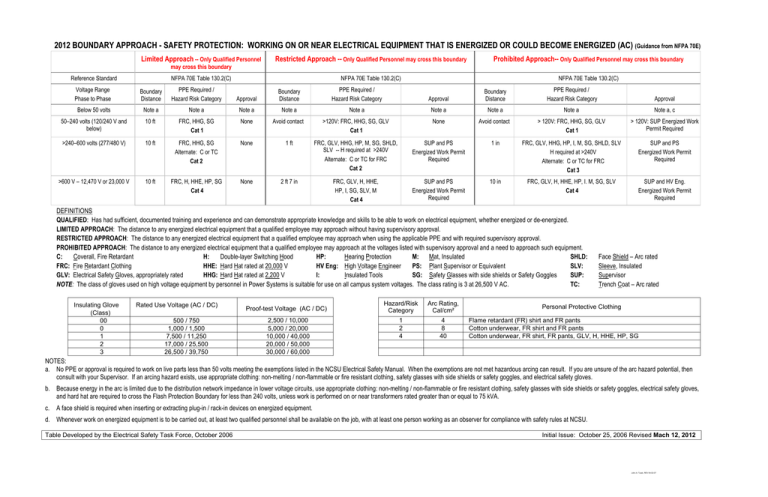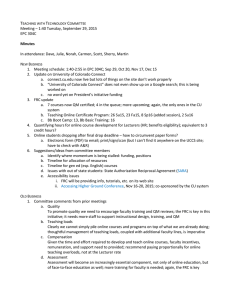Boundary Approach - SAFETY PROTECTION: WORKING ON OR
advertisement

2012 BOUNDARY APPROACH - SAFETY PROTECTION: WORKING ON OR NEAR ELECTRICAL EQUIPMENT THAT IS ENERGIZED OR COULD BECOME ENERGIZED (AC) (Guidance from NFPA 70E) Limited Approach -- Only Qualified Personnel Restricted Approach -- Only Qualified Personnel may cross this boundary Prohibited Approach-- Only Qualified Personnel may cross this boundary NFPA 70E Table 130.2(C) NFPA 70E Table 130.2(C) NFPA 70E Table 130.2(C) may cross this boundary Reference Standard Voltage Range Phase to Phase Boundary Distance PPE Required / Hazard Risk Category Approval Boundary Distance PPE Required / Hazard Risk Category Below 50 volts Note a 50–240 volts (120/240 V and below) Approval Boundary Distance PPE Required / Hazard Risk Category Approval Note a Note a Note a Note a Note a Note a Note a Note a, c 10 ft FRC, HHG, SG Cat 1 None Avoid contact >120V: FRC, HHG, SG, GLV Cat 1 None Avoid contact > 120V: FRC, HHG, SG, GLV Cat 1 > 120V: SUP Energized Work Permit Required >240–600 volts (277/480 V) 10 ft FRC, HHG, SG Alternate: C or TC Cat 2 None 1 ft FRC, GLV, HHG, HP, M, SG, SHLD, SLV -- H required at >240V Alternate: C or TC for FRC Cat 2 SUP and PS Energized Work Permit Required 1 in FRC, GLV, HHG, HP, I, M, SG, SHLD, SLV H required at >240V Alternate: C or TC for FRC Cat 3 SUP and PS Energized Work Permit Required >600 V – 12,470 V or 23,000 V 10 ft FRC, H, HHE, HP, SG Cat 4 None 2 ft 7 in FRC, GLV, H, HHE, HP, I, SG, SLV, M Cat 4 SUP and PS Energized Work Permit Required 10 in FRC, GLV, H, HHE, HP, I. M, SG, SLV Cat 4 SUP and HV Eng. Energized Work Permit Required DEFINITIONS QUALIFIED: Has had sufficient, documented training and experience and can demonstrate appropriate knowledge and skills to be able to work on electrical equipment, whether energized or de-energized. LIMITED APPROACH: The distance to any energized electrical equipment that a qualified employee may approach without having supervisory approval. RESTRICTED APPROACH: The distance to any energized electrical equipment that a qualified employee may approach when using the applicable PPE and with required supervisory approval. PROHIBITED APPROACH: The distance to any energized electrical equipment that a qualified employee may approach at the voltages listed with supervisory approval and a need to approach such equipment. C: Coverall, Fire Retardant H: Double-layer Switching Hood HP: Hearing Protection M: Mat, Insulated SHLD: FRC: Fire Retardant Clothing HHE: Hard Hat rated at 20,000 V HV Eng: High Voltage Engineer PS: Plant Supervisor or Equivalent SLV: GLV: Electrical Safety Gloves, appropriately rated HHG: Hard Hat rated at 2,200 V I: Insulated Tools SG: Safety Glasses with side shields or Safety Goggles SUP: NOTE: The class of gloves used on high voltage equipment by personnel in Power Systems is suitable for use on all campus system voltages. The class rating is 3 at 26,500 V AC. TC: Insulating Glove (Class) 00 0 1 2 3 Rated Use Voltage (AC / DC) 500 / 750 1,000 / 1,500 7,500 / 11,250 17,000 / 25,500 26,500 / 39,750 Proof-test Voltage (AC / DC) 2,500 / 10,000 5,000 / 20,000 10,000 / 40,000 20,000 / 50,000 30,000 / 60,000 Hazard/Risk Category Arc Rating, Cal/cm² 1 2 4 4 8 40 Face Shield – Arc rated Sleeve, Insulated Supervisor Trench Coat – Arc rated Personal Protective Clothing Flame retardant (FR) shirt and FR pants Cotton underwear, FR shirt and FR pants Cotton underwear, FR shirt, FR pants, GLV, H, HHE, HP, SG NOTES: a. No PPE or approval is required to work on live parts less than 50 volts meeting the exemptions listed in the NCSU Electrical Safety Manual. When the exemptions are not met hazardous arcing can result. If you are unsure of the arc hazard potential, then consult with your Supervisor. If an arcing hazard exists, use appropriate clothing: non-melting / non-flammable or fire resistant clothing, safety glasses with side shields or safety goggles, and electrical safety gloves. b. Because energy in the arc is limited due to the distribution network impedance in lower voltage circuits, use appropriate clothing: non-melting / non-flammable or fire resistant clothing, safety glasses with side shields or safety goggles, electrical safety gloves, and hard hat are required to cross the Flash Protection Boundary for less than 240 volts, unless work is performed on or near transformers rated greater than or equal to 75 kVA. c. A face shield is required when inserting or extracting plug-in / rack-in devices on energized equipment. d. Whenever work on energized equipment is to be carried out, at least two qualified personnel shall be available on the job, with at least one person working as an observer for compliance with safety rules at NCSU. Table Developed by the Electrical Safety Task Force, October 2006 Initial Issue: October 25, 2006 Revised Mach 12, 2012 John A. Turek, REV 04-02-07

